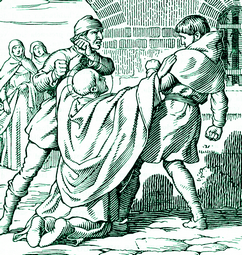Lives of the Saints
Our Models and Protectors
Spiritual Bouquet:
April 1st

Saint Hugh
Bishop of Grenoble
(1053-1132)
It was the good fortune of Saint Hugh to receive, from his cradle, strong impressions of piety through the example and solicitude of his illustrious and holy parents. He was born at Chateauneuf in Dauphiné, France, in 1053. His father, Odilo, who served his country in an honorable post in the army, labored by all means in his power to make his soldiers faithful servants of their Creator, and by severe punishments, to restrain vice. By the advice of his son, Saint Hugh, in his later years he became a Carthusian monk, and died at the age of one hundred, having received Extreme Unction and Viaticum from the hands of his son. Under his direction, his mother had served God in her own house for many years by prayer, fasting, and abundant almsgiving; and Saint Hugh also assisted her in her last hours.
Hugh, from the cradle, appeared to be a child of benediction; in his youth he was recognized as such through his exceptional success in his studies. Having chosen to serve God in the ecclesiastical state, he accepted a canonry in the cathedral of Valence. His great sanctity and learning rendered him an ornament of that church, and at the age of twenty-seven he was chosen Bishop of Grenoble. Pope Gregory VII consecrated him in Rome, and inspired in him an ardent zeal for the Church's liberty and the sanctification of the clergy. He at once undertook to reprove vice and reform abuses, at that time rampant in his diocese, but found his efforts without fruit. He resolved therefore, after two years, to resign his charge, and retired to the austere abbey of Casa Dei, or Chaise-Dieu, in Auvergne.
There Saint Hugh lived for a year, a perfect model of all virtues in a monastery filled with saints, until Pope Gregory commanded him, in the name of holy obedience, to resume his pastoral charge, saying: Go to your flock; they need you. This time his sanctity effected great good in souls. His forceful preaching moved crowds and touched hearts; in the confessional he wept with his penitents, and aroused in them a deeper contrition. After a few years the face of his diocese had changed. His charity for the poor led him to sell even his episcopal ring and his chalice to assist them. During his episcopate the young Saint Bruno came to him for counsel, and it was Saint Hugh who assisted him in the foundation of the Carthusian Monastery in the mountains of the diocese of Grenoble, whose renown after a thousand years has not diminished.
Always filled with a profound sense of his own unworthiness, he earnestly solicited three Popes for leave to resign his bishopric, that he might die in solitude, but was never able to obtain his request. God was pleased to purify his soul by a lingering illness before He called him to Himself. He closed his penitential course on the 1st of April in 1132, two months before completing his eightieth year. Miracles attested the sanctity of his death, and he was canonized only two years afterwards, by Pope Innocent II.
Reflection. Let us learn from the example of the Saints to shun the tumult of the world as much as our circumstances will allow, and apply ourselves to the exercises of holy solitude, prayer, and pious reading.
Little Pictorial Lives of the Saints, a compilation based on Butler's Lives of the Saints and other sources by John Gilmary Shea (Benziger Brothers: New York, 1894); Vie des Saints pour tous les jours de l'année, by Abbé L. Jaud (Mame: Tours, 1950); Les Petits Bollandistes: Vies des Saints, by Msgr. Paul Guérin (Bloud et Barral: Paris, 1882), Vol. 4